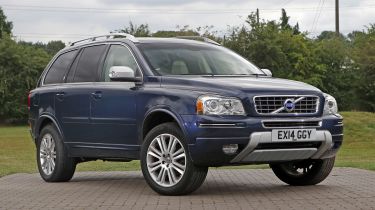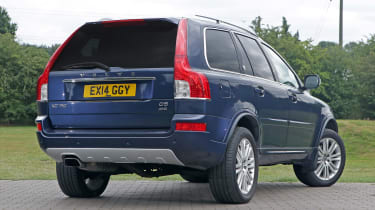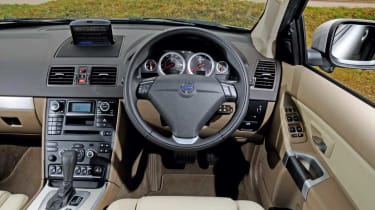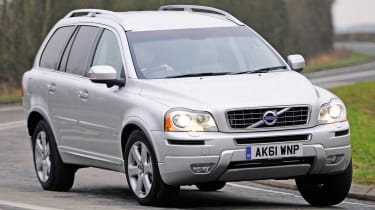Used Volvo XC90 (Mk1, 2002-2014) review
The Volvo XC90 Mk1 is a very spacious and versatile family SUV, though it’s also on the pricey side to run
Verdict
If you’re after a roomy and practical large SUV, then the Volvo XC90 Mk1 could be worth bearing in mind. With its spacious cabin and versatile seven-seater layout, the Volvo is great for carrying lots of passengers, and the comfy ride and good refinement levels means it’s also good on long family outing drives. While the XC90 Mk1 does still fare well in practicality in comfort, other areas such as design and fuel efficiency are starting to show the car’s age. Likewise, reliability is something to consider when you’re shopping around, especially if you’re looking at earlier or well-used examples in the classifieds.
Which one should I buy?
- Best Volvo XC90 Mk1 for low costs: 2.4 D5 S Geartronic
- Best Volvo XC90 Mk1 for performance: 4.4 V8 R-Design Geartronic
- Best Volvo XC90 Mk1 for long journeys :2.4 D5 Executive Geartronic
The Volvo XC90 Mk1’s size isn’t the only thing that’s big about it – it also had a very long production run, from 2002 all the way up to 2014. Over that time, the Volvo XC90 was updated and adjusted on numerous occasions, so the specification can vary depending on the car’s age.
From launch in November 2002, the Volvo XC90 Mk1 was only available with two engine options: a 2.4-litre diesel with 161bhp and a 272bhp 2.9-litre petrol, which would later be renamed as D5 and T6 engines respectively. More variety to the powerplant portfolio would emerge in September 2004, when the 210bhp 2.5T petrol joined the range, and the D5’s power was upped to 183bhp in summer 2005.
Used - available now
The following summer saw the XC90 Mk1 receive its first facelift, which lightly retouched the exterior design and updated the interior with more upmarket-feeling materials. This facelift also heralded the introduction of the range-topping 4.4-litre petrol V8 engine.
In January 2011, the D5 diesel had its power upped to 194bhp, and the following year the XC90 Mk1 received new LED lights and a refreshed infotainment system as part of a second facelift. The first-gen Volvo XC90 would then soldier on in this guise – and, latterly, only with the diesel engine on the order form – until it was removed from sale in 2014. In December 2014, the first-gen Volvo XC90 was replaced with a second-generation model.
What are the alternatives?
The Volvo XC90 Mk1 may date back to a time when big SUVs weren’t as widely available as they are now, but that doesn’t mean the car faced limited competition. In the premium seven-seater SUV space, the Volvo’s contemporary rivals included the likes of the Land Rover Discovery, the Mercedes GL and the Audi Q7, although the latter two weren’t quite as roomy as the XC90.
If you aren’t just looking for upmarket options, there are also more mainstream alternatives to the Volvo XC90 Mk1, such as the Mitsubishi Shogun. The Volkswagen Touareg is also a worthy shout, because it fills the gap between the more mass-market Mitsubishi and the upmarket Volvo, albeit as only a five-seater.
Volvo XC90 vs Land Rover Discovery vs Mercedes GL
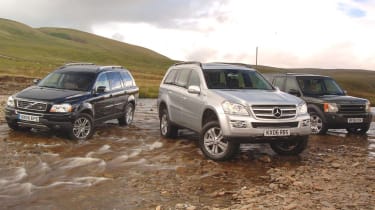
In our three-way three-row SUV showdown from October 2006, the Volvo XC90 was compared and contrasted with the Land Rover Discovery and Mercedes GL. Overall, we were impressed with the XC90’s versatile seating system and its relative affordability, but we reckoned it was lacking in too many areas to topple the Land Rover and Mercedes in this group test. Read the full test...
Volvo XC90 vs Renault Grand Modus vs Honda Accord Tourer vs Hyundai i30 Tourer
In June 2008, we included the Volvo XC90 in a group test with a difference. Rather than pitting it against other premium SUVs, we wanted to see how the Volvo compared with alternative estate and MPV family cars. Being the biggest car here with the largest seating capacity, the Volvo impressed with its practicality, and then we marked it down because it was the most expensive of the quartet to buy and run – meaning it may not be the ideal family car for you unless you really need the extra seats. Read the full test...
How much will a used Volvo XC90 Mk1 cost?
Because the Volvo XC90 Mk1 was on sale for 12 years, how much you’ll pay for one varies depending on its age. Earlier examples will generally be the most affordable ones, and expect to pay the most for younger versions with fewer miles and less wear and tear. Even the youngest Volvo XC90 Mk1s date back to 2014, but the upside of this is that depreciation should have made even these versions considerably more affordable. Nevertheless, you can expect to pay more for an XC90 than an equivalent alternative from a more mainstream manufacturer.
Do make sure you check out the used listings on our Find a Car service, so you can find out how much you’ll need to pay for a used Volvo XC90 Mk1 in your ideal spec and condition or you can value a specific model using our free car valuation tool.
Fuel economy and emissions
In comparison with some of the other large SUVs on sale at the same time, the Volvo XC90 Mk1’s fuel economy isn’t that impressive. Even the most efficient version (the 2.4-litre D5 diesel) could return up to 34.4mpg, and the 219g/km of CO2 emissions means this version is also pricey to tax.
Unsurprisingly, the petrol models have an even greater thirst for fuel. The 2.5-litre T5 models returned up to 25.2mpg and 269g/km of CO2, and the more powerful-still T6 petrol versions managing 23.9mpg and 289g/km. You’ll need very deep pockets to run models with the 4.4-litre V8 under the bonnet, as these versions are capable of 20.9mpg and emit 322g/km of CO2.
Running costs
The Volvo XC90 Mk1 will need to be serviced once every 12 months or 18,000 miles, whichever comes sooner. Being a premium product, servicing costs are a bit on the pricey side: Services alternate between minor and major, and will set you back £200 and £400 respectively, and the big service that needs to be done once every six years/108,000 will cost around £800.
The car’s coolant is checked at each service, and will only be replaced if necessary, but you will need to have the brake fluid change at every other service. Diesel and T6 petrol models also have a cambelt that needs replacing once every 10 years/108,000 miles, and this will be carried out as part of the previously mentioned big service. The rest of the Volvo XC90 Mk1’s engines are chain driven, so there’s no cambelt to replace on these models.
What do owners think?
The Volvo XC90 Mk1 is quite an old car now, so won’t be as mechanically dependable as a newer one. As a result, it’s important that you make sure you’re buying one in the best condition possible to reduce the chance of any big and expensive repair jobs being needed in the foreseeable future. Towards the end of its lifecycle, the Volvo XC90 Mk1 performed poorly in our Driver Power customer satisfaction surveys, with the biggest blemishes to its record being reliability, fuel economy and its dated design.
Reliability
The Volvo XC90 Mk1 is getting on a bit now – even the youngest examples are nearing eight years old at the time of writing – which means reliability is something you’ll need to be aware of. This is reflected in its most recent Driver Power owner survey results: in the 2015 edition, the XC90 Mk1 was ranked 185th for reliability. Therefore, you should buy a used first-generation XC90 with care – especially if you decide to go for an older or a higher mileage example.
How practical is it?
One of the most appealing aspects of the Volvo XC90 Mk1 is its practicality. The seven-seater layout means this large SUV is very versatile, and the Volvo’s boxy shape means adults won’t be rubbing their heads on the roof lining. Those proportions also help contribute to a spacious boot, but don’t expect to fit lots in the back when all seven seats are in use. Across the board, equipment levels are pretty decent, and the Volvo XC90 Mk1 has strong safety credentials for a car of this age.
Dimensions, cabin and boot space
As suggested by its size and seating capacity, the Volvo XC90 Mk1 is a pretty big car. At 4,800mm long, 1,900mm wide, and 1,790mm tall, the first-gen model isn’t that much smaller than the Mk2 model (4,933mm long/1,923mm wide/1,773mm tall).
Thanks to that size, the car’s boxy proportions and the wheelbase length (the distance between the front and rear axles) of 2,860mm, the first-generation Volvo XC90 also boasts a roomy interior. The front and middle rows of seats offer lots of head- and legroom for taller passengers and, while the two rear seats in the third row are a bit on the small side for adults, they’re great for children. The middle row seats are handily versatile, too, as the three chairs can recline and slide forwards and backwards independently of each other.
As in many other seven-seaters, there isn’t a vast amount of luggage room on offer when all the seats are in use – the available 245 litres of boot space is respectable but no more. Folding down the third row of seats flat into the boot floor increases the load area to 615 litres, which grows even further to a cavernous 1,837 litres when you also fold the middle row of seats down. Making it even easier to load and unload larger, bulkier items are the boxy boot opening and the large split-folding tailgate.
Equipment and technology
The Volvo XC90 range was updated numerous times over its long production life, so exact specifications do vary depending on the model and when it was produced. The S and ES trim levels were the entry-level versions and, depending on when the car was built, came with rear parking sensors, climate control, cruise control, self-levelling suspension and built-in navigation. Further up the trim level range was the SE spec, which fleshed out the equipment list with leather seat trim and a power-adjustable driver’s seat.
At the top of the Volvo XC90 Mk1 trim level tree was the Executive specification, which included higher-end kit such as an upgraded sound system, ventilated front seats and higher-grade interior trim materials like walnut wood inlays on the dashboard.
If you’d prefer to have a slightly sportier XC90, there was also an R-Design model which came with the same equipment as SE cars, but was a bit more dynamic to look at and drive thanks to touches like more supportive front seats and slightly firmer suspension to improve handling.
Safety
For its time, the Volvo XC90 had very good safety credentials. In its Euro NCAP crash test, the car was awarded the maximum-possible five stars for adult protection, and was commended for its child passenger protection qualities, too. However, pedestrian protection was only deemed to be fair, and do bear in mind Euro NCAP’s crash test procedure is much more stringent now than it was when the XC90 Mk1 was assessed in 2003.
Overall, the Volvo XC90 Mk1 came with a pretty good amount of safety equipment. All cars were fitted with stability control, front, side and curtain airbags and ISOFIX child seat mounting points.
What’s it like to drive?
The Volvo XC90 Mk1 is a big car that puts its eggs in the comfort basket, so while it isn’t the most fun family SUV to drive, it is very relaxing. This is aided by the smooth and refined engine options, which all are capable of respectable performance. However, even the diesel models aren’t that efficient, and the petrols are even worse for fuel economy.
Engines and performance
A majority of the used Volvo XC90 Mk1 examples you’ll come across will likely be the 2.4-litre D5 models, as the engine used in this version was one of the most well-rounded options available on the car from new. While power outputs varied over time (early cars had 161bhp, whereas the latest versions had 197bhp at their disposal), the D5 diesel had decent performance and enough punch for towing duties. It’s also the most fuel-efficient engine available on the first-generation XC90, by some margin.
Throughout the XC90 Mk1’s lifecycle, a suite of petrol engines was also available. These options ranged from an entry-level T5 petrol (originally a 210bhp 2.5-litre engine, which was replaced with a 236bhp 2.9-litre in 2006), to a 276bhp 3.2-litre petrol in T6 cars. For a very limited time, there was also a 311bhp 4.4-litre V8 model, although these didn’t sell in huge numbers due to the high list price and steep running costs.
While their power and performance outputs varied, all of the Volvo XC90 Mk1’s engines were smooth and refined, save for some diesels that could be a bit boomy under hard acceleration. The extra grunt of the V8 is especially handy if you do lots of towing and can stomach the fuel consumption.
On the road
If you’re after a sporty seven-seater SUV, then the Volvo XC90 Mk1 won’t be an ideal pick. Even the R-Design models with their firmer suspension aren’t as responsive or as fun to drive as rivals such as the BMW X5. However, because the XC90 Mk1 has a supple ride and is very refined even at motorway speeds, it’s much more appealing as a comfort-oriented pick.
The Volvo gives the driver a good view out of the road ahead, and overall visibility is pretty good. However, the large turning circle makes manoeuvring the car at lower speeds and in tighter spots like car parks quite awkward. This isn’t helped by the bluff front end, which can make accurately judging the nose a bit tricky.
As standard, all Volvo XC90 Mk1s were all-wheel drive, which is a handy feature to have when towing or driving in slippery conditions. Factor in the raised ride height, and the Volvo has respectable light off-road driving credentials. That said, you’ll be better off with a Land Rover Discovery if you regularly venture well off the beaten path.
A six-speed manual gearbox was available on some of the XC90’s engine options, but most examples you’ll find in the classifieds will likely have the six-speed automatic instead. The manual gearbox is fine to use, but the smooth-shifting automatic is a better fit for the Volvo’s laid-back character.
What should you look out for?
Because of the car’s age, reliability will be one of the bigger concerns with the Volvo XC90 Mk1, so it’s best you opt for the most mechanically sound example possible. Expect the car to have a bit of general wear and tear on it, too, especially if it’s an older car that’s had a well-used life.
Common used Volvo XC90 Mk1 problems
Boot release
The actuator rod can rust and swell, causing the tailgate to stick. The fix for this is straightforward, and merely involves removing trim panels inside the boot area.
Interior trim
Take note of the cabin trim pieces on the Volvo XC90 Mk1, because these can show signs of wear and tear – especially on well-used examples. For example, the leather upholstery can be scuffed and the carpets can look tatty.
Chrome
The exterior chrome trim can go cloudy over time. Some cleaning products are able to bring the trim back to its former shiny glory – if that doesn’t work, the only option is to replace the trim.
Injectors
D5 diesel models that struggle to fire up on a cold start may have problems with the engine’s injectors. Brace yourself for a pricey repair job if the injectors need replacing.
Recalls
In total, 18 recalls have been issued for the Volvo XC90 Mk1, although not all of them affected every variant – some only involved a handful of models. The most recent recall for the XC90 Mk1 was issued in July 2015, so it’s likely the used example you’re looking at would have had the recall work carried out by now. Still, check the vehicle’s recall history to make sure before committing to a purchase.
Examples of issues the Volvo XC90 Mk1 was recalled for include power-steering and injector fuel leaks, faulty ABS and seatbelts, engine stalls, steering failure and jammed gearboxes on manual models.
